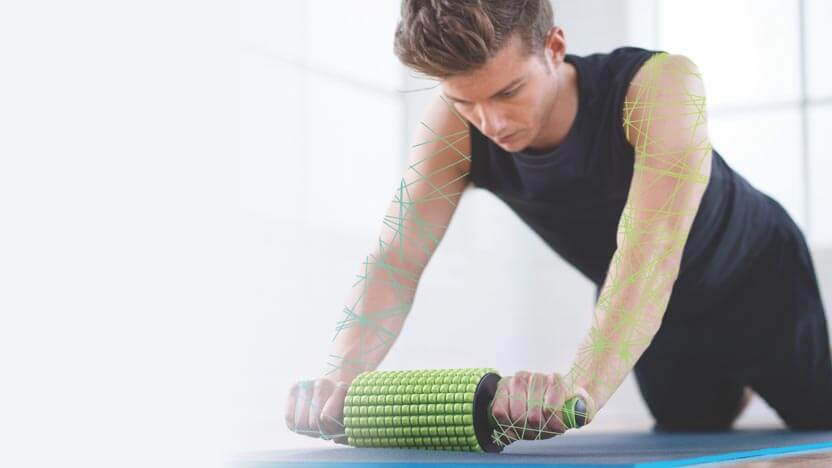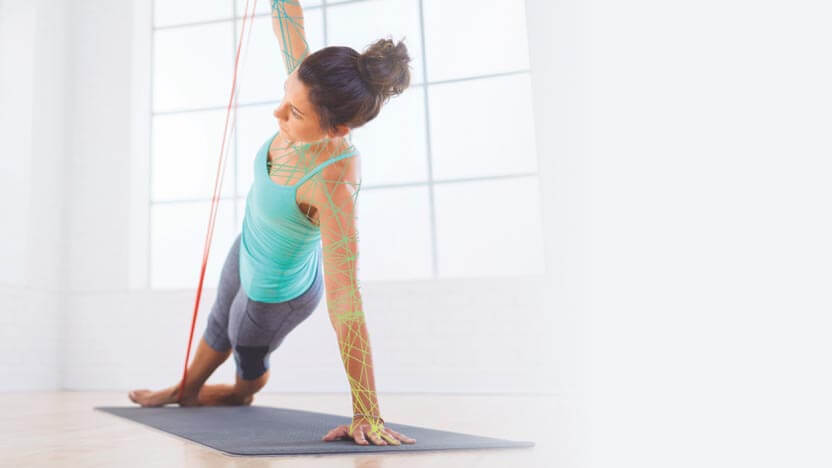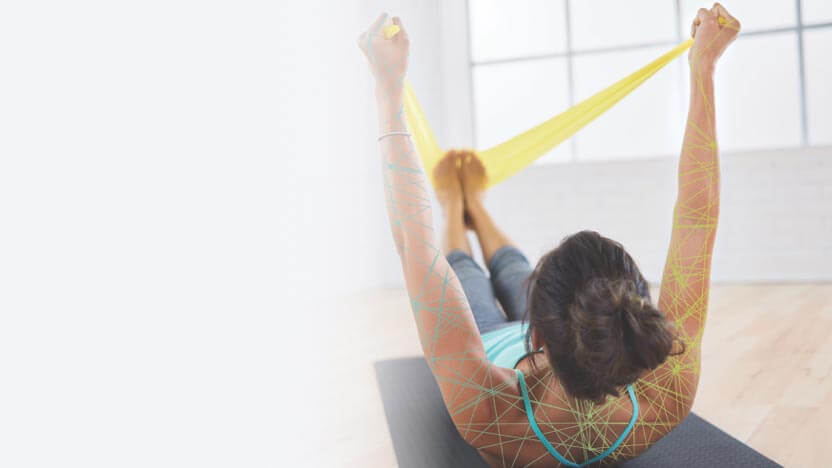
Merrithew® Master Instructor Trainer Laureen DuBeau explains what fascia is and what it does, why it’s an important concept to understand, and how fitness instructors can apply the four Fascial Movement Variables— Bounce, Sense, Expand and Hydrate— to any form of exercise.
You’ve likely been hearing more about the fascial system and the desire to incorporate it into your training.
If you’re not really sure what that means or how to make it part of your teaching vernacular, we’re here to help.
First of all, you don’t have to re-learn everything you know. Incorporating some fascial concepts into your teaching is quite simple, and might be something you’re doing already. Bringing an awareness of fascia to your training can be done regardless of the type of training you do.
These principles are as appropriate to apply to the STOTT PILATES® system as they are to Total Barre® and Halo® Training, and as integral to ZEN•GA® programming as well.
Post-rehabilitation, restorative fitness and even athletic conditioning and performance training programs will benefit by focusing on one or more of these fascial movement concepts.
What is fascia and what does it do?
Fascia is commonly thought of as connective tissue, comprising tendons and ligaments. There are so many different varieties of fascia, even the experts have a hard time agreeing on a definition.
The density and organization of fascial tissue range from thick cords, like the Achilles tendon, to thin sheets wrapping and separating as in the intramuscular septa, all the way to a gooey, gluey substance that fills the spaces between our internal organs.
More important than what fascia looks like, is what fascia does, and the array is just as wide.
Fascial tissue binds things together, but also holds them apart. It makes them glide and slide, but provides integrity. It acts as a body-wide communication system, providing six times more information to the brain that the sensory organs combined. The fascial lines or continuities act as transmission belts, helping the body manage and distribute forces through the body.
So, fascia is pretty important to just about everything.

Why do fitness instructors need to understand how fascia behaves?
Understanding how fascia behaves will allow us to access its potential in everyday activities or high-level athletic pursuits.
The Merrithew Fascial Movement Variables were created to illustrate how instructors can simply and easily target the body’s fascial system in any kind of exercise programming. When we look at developing a healthy, resilient, mobile and strong body, this global approach makes sense and provides greater results.
The Fascial Movement Variables are: Bounce, Sense, Expand and Hydrate. They can all be integrated easily into the exercises we already know.
The FMVs, as we like to call them, are not exclusive to the Fascial Movement program. These variables refer to movement qualities that can be found in every Merrithew education program, including STOTT PILATES, Total Barre and Halo Training, and they can be applied to any other kind of physical fitness or athletic training.
1. Fascial Movement Variable: Bounce
The idea of Bounce relates to creating and sustaining rhythmic movements in the body. By incorporating ideas like pre-tension and recoil, a familiar concept in plyometric training, we look for effortless, non-muscular movement. The crimped configuration of some fascia allows for that bouncy quality.
Like Tigger’s tail from Winnie the Pooh, healthy fascia provides spring to our movements and results in a more playful quality. The healthier the fascia, the springier it is. Healthy tissues can absorb and distribute forces better than those that are stuck and stiff. Movements where we can experience the elastic potential of fascial tissue can be found in ZEN•GA and Total Barre programming.
Try these movements:
- Spine Twist Sitting - find the end range then add easy pulses to increase it
- Loaded Bounces Standing - with soft knees, gently bounce letting the heels lift off the ground, gradually increase the amplitude to small jumps
- Supine Leg Bounce - lie with long legs, one resting on a Mini Stability Ball™, allow the leg to bounce on the ball without making it too much work
- Add music – doing any kind of movement to music can spark and sustain a rhythm, making bounce easier
2. Fascial Movement Variable: Sense
Sense brings us back to the fascia’s ability to relay important information about what is going on in the body back to the brain. There are different types of nerve endings found within the fascial system. They are: proprioceptors that sense body position in relationship to the environment; exteroceptors that recognize stimulators outside our body; and interoceptors that include internal perceptions as well as our sense of self. We can use textured props, or those with unstable surfaces, vibration or heat to stimulate the various receptors.
Try these movements:
- Ab Prep – use a spikey Air Balance Ball behind the back to stimulate the receptors in the skin
- IT Band Rolling – a textured roller will enhance the feedback from the targeted tissues, but it should never be painful
- Focused Vibration – a vibrational tool like the Fascia Releazer® can target the parasympathetic nervous system causing a sense of calm and relaxation
- Quiet Breathing – noticing a natural breath pattern allows the involuntary activity to occur without ‘making’ it happen
3. Fascial Movement Variable: Hydrate
The Hydrate Variable addresses tissue hydration. Water is one of the main components of healthy fascia and the lack of water causes the tissue to become dense and stuck. Making water available is only part of the solution.
Think of pouring water on a dried-out sponge, most of it just rolls off. In order to get the water to soak in, we have to manipulate the sponge, squeezing it to allow the fluid to get into all the little nooks and crannies.
Swinging, twisting and undulating patterns can help achieve this goal in fascial tissue. We can also experience this variable in developmental or animalistic patterns. This is also where the concept of ‘rolling out’ tissues, as in using Foam Rollers™ or small balls.
Try these movements:
- Arm Swings with Twist Ball™ – in an offset stance, swing the Twist Ball forward and back, allowing the weight of the ball to rotate the torso and stabilize the shoulder
- Quadruped Gait Mechanics – with one knee on a Mini Stability Ball, step forward with opposite hand, pulling knee on ball forward, then return
- Spread Eagle on Stability Chair™ – standing on pedal, holding handles, hinged at hips, articulate from tailbone to move through flexion and extension of the hips and spine. Try reversing the pattern
4. Fascial Movement Variable: Expand
Last is the Expand Variable, which illustrates the ability of fascia to transmit forces and manage loads through the body. It’s arguably one of the easier variables to appreciate.
Often described as force transmission belts, fascial lines explain how the connective tissue of one muscle doesn’t necessarily end, but continues to become the connective tissue of another muscle with fibres running in the same direction.
Consider the latissimus dorsi and contralateral (on the other side) gluteus maximus. Follow the direction of the fibres and you can see how one becomes the other after crossing the thoraco-lumbar fascia.
Consider a standard gait pattern: As one leg extends back, the opposite arm moves back, and the targeted muscles work together. Isolated strengthening movements can be useful, but incorporating both muscles is an even more efficient and effective strategy.
Try these movements:
- Single Leg and Arm Extension – in prone, extend one hip and the opposite shoulder
- Back Lunge and Lat Press – step back into a lunge while performing a lat press with an Arm Spring on the other side
- Quadruped (hands and knees) - single leg lift with knee flexed on one side, arm reach to the side with torso rotation on the other
- Shoulder Bridge – lift leg to tabletop on one side, reach the opposite arm to the ceiling (focus on supporting side)

Understanding tensegrity
The Expand Variable brings us to the idea of ‘tensegrity,’ which is creating a body with tensional and structural integrity. The simplest way of incorporating this concept is through opposition. In every exercise or movement, we can feel energy originating from the centre of the body and expanding outward. This can also be linked to the primary movement patterns of ‘push’ and ‘pull.’
Try these movements:
- While standing – feel the feet pressing into the floor and the head reaching up to the ceiling even before the movement starts
- While in rotation – push one arm forward and pull the other arm back to increase the rotation and the engagement of the abdominal muscles
- Reformer Footwork – press the feet into the Footbar while pulling the head away
Are you ready to incorporate the Fascial Movement Variables into your next lesson?
These exercises are only a small example of how, by incorporating these variables, results can be found more efficiently and effectively. It isn’t really about learning something new, it’s just a matter of being knowledgeable about how to use movements with a slightly different focus and with a purposeful quality. When instructors make even a small change in programming, making it more practical, clients can become more functional in their everyday lives.